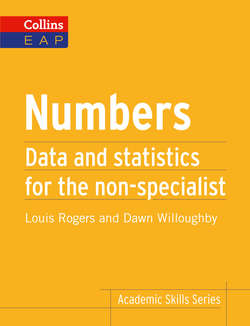Читать книгу Numbers: B2+ - Dawn Willoughby - Страница 6
1 Getting Started
ОглавлениеAims
look at numbers in everyday life
understand the purpose and use of statistics
learn key terms for working with numbers
learn the basics about spreadsheets
practise referring to and labelling graphics in writing
Quiz
Self-evaluation
Read the statements below. Circle the answers that are true for you.
| 1 I understand what statistics is and the language to describe it. | agree | disagree | not sure |
| 2 I know a number of basic terms and phrases to describe numbers in English. | agree | disagree | not sure |
| 3 I know how to use a spreadsheet. | agree | disagree | not sure |
| 4 I know how to refer to and label graphics such as bar charts and line graphs in writing. | agree | disagree | not sure |
Numbers and mathematics are very important in our everyday lives because we use them frequently when we manage our finances, go shopping, make travel plans, convert currency, follow instructions for a recipe or take measurements when we are building and creating things. If we carry out an academic study or investigation, then we need to use a branch of mathematics known as statistics which involves collecting and organizing data, making sense of our information and presenting findings.
Glossary
data You can refer to information as data, especially when it is in the form of facts or statistics that you can analyse. In American English, data is usually a plural noun. In technical or formal British English, data is sometimes a plural noun, but at other times, it is an uncountable noun.
This chapter begins by reminding us of the calculations and vocabulary that are used when we are working with money and taking measurements. It then provides an introduction to statistics, explaining where data is used in different subject areas and describing different categories of data. With a more technical focus, the chapter then describes how to use a computer program known as a spreadsheet which can help with storing and presenting data. Finally, an explanation is given of the use of graphics in academic writing, highlighting ways to refer to graphics in your text so that you can comment on your data and findings effectively.
